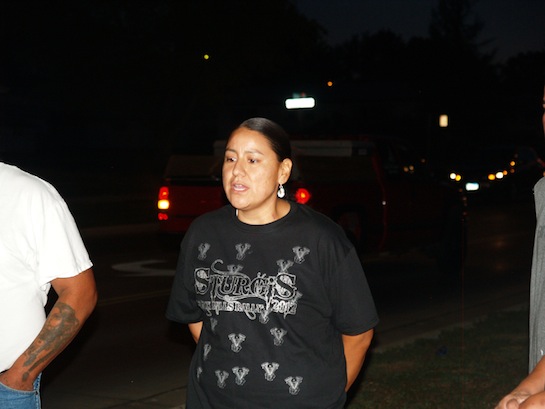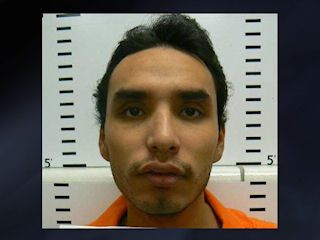
Jenn Ghost Bear, Oglala Lakota, pays powerful tribute, in the form of a prayer and grief song, to fallen Oglala Lakota warrior Daniel Tiger, who was killed in a violent confrontation with three Rapid City Police Department officers on Aug. 2, 2011.

Daniel Tiger
Honoring Daniel Tiger
By Jesse Abernathy
Native Sun News Editor RAPID CITY — As the rest of Rapid City paid tribute to the police officers killed in the line of duty last Aug. 2, a small group of the city’s Native American residents quietly gathered to remember the other victim killed in last year’s tragic shootout – Daniel Tiger. On the one-year anniversary of the violent altercation – widely reported to have begun as a “routine stop” for what was officially deemed “suspicious behavior” – Tiger, an Oglala Lakota, was eulogized and mourned by about 20 family members and friends. The memorial service began at 7 p.m. in College Park, which lies in the heart of North Rapid City and is a few blocks southwest of the spot where 22-year-old Tiger and two officers from the Rapid City Police Department, Nick Armstrong and Ryan McCandless, exchanged gunfire on Aug. 2, 2011. Tiger died Wednesday, Aug. 3, 2011, at Rapid City Regional Hospital. The incident forever changed the face of Rapid City, bringing ethnic dissimilarities to the forefront for virtually all citizens and serving to further divide the Native American and non-Native American communities. As a summer thunderstorm threatened to prematurely end the memorial service, Tiger’s family members and friends assembled under College Park’s lone picnic shelter in the southwest corner. One by one, they spoke in earnest about Tiger’s life and about the current state of race relations in Rapid City, especially between the Native community and the city’s police department. One woman, an elder, told of how six non-Native Rapid City police officers harassed her at her home while searching for a Native suspect they falsely believed she was harboring. “I would like to know just how many officers currently on the force in Rapid City are Native American,” another woman said. “There needs to be more put out to patrol in Rapid City; there needs to be more Native American police officers,” she added. The group noted that a former Native American officer with Rapid City’s police force, Lisa White Face, is no longer serving the city. “(The Rapid City Police Department) pushed her out of here,” said the female elder, referring to White Face. Tad Montgomery, head of the Sioux Addition Civic Association, which is based near Lakota Homes, eloquently remembered Tiger in his first language of Lakota. “(Daniel Tiger) was more than just my cousin, he was my little brother,” Montgomery added in English. “We grew up together; we both came from broken homes. I remember him from since before there was a Head Start we attended. We grew up in the same family. I can’t tell you how close I was to Daniel,” he said, as the thunder rolled. “Do you hear that? They’re coming; the Wakinyan (Thunder Beings) are coming,” Montgomery said, then looked to the lightning in the northern sky. In traditional Lakota culture, Thunder Beings are said to have the power to give life but also to take it away. They can destroy with wind, cause flood and drought, or burn with lightning. But at the same time, Thunder Beings can renew and bring vital rain and nurture all life on earth. Montgomery said Tiger was raised by his grandmother and was a respectful, good “grandma’s boy.” “The last time I saw Daniel was a week before he died,” Montgomery recalled. “He said he was going to start roofing with us. He said he got a job doing that down in Denver. That was the last time I saw Daniel.” “The last thing Daniel said to me was, ‘Do you have a canli (cigarette) I can borrow?’ That was the last time I got to see him. And I felt bad because everything that was portrayed about him in the (Rapid City Journal) and everybody that had something bad to say, they really didn’t know him.” Many Native American critics from within the Rapid City community say the police department as well as local media outlets – with the noted exception of Native Sun News – overtly and unnecessarily criminalized Tiger simply because he was a young Native American male. “Doesn’t everybody make mistakes, and especially living in this city?” Montgomery continued. “(Native Americans) have to put up with a lot. This life is really hard – it’s lila otehika – for all of us. It’s negative. Everything’s negative about being wo’lakota (living in balance and harmony as a Lakota) in this city. (Non-Native Americans) will shoot you down any way they can. That’s been going on for so long, I lost track of how many Native Americans have been shot down by cops – and now Daniel.” Montgomery says that everything portrayed in the non-Native media about Tiger is not true and that the vilification of his young cousin “hurt my feelings.” “Natives never got a chance to mourn” the death of Tiger “in the proper way, with respect – uonihan,” he said, his voice wavering with emotion. “Daniel’s funeral service had to be secretive because of the threats made against his family by people who didn’t know him.” Tiger “got caught up in the system,” and “racism did have a part in what happened – you can’t tell me it didn’t,” said Montgomery loudly, his voice now beginning to compete with sudden, but short-lived, gusts of wind. At approximately 8 p.m., while the storm dissipated just as quickly as it had tried to encroach, the group of mourners decided to continue the ceremony at the place near East Anamosa and Greenbriar streets where Tiger was fatally wounded. The Rapid City Police Department was simultaneously paying tribute to Armstrong and McCandless at the corner next to New Beginnings Baptist Church, at the Fallen Officer Memorial erected last fall in honor of the officers. Many Rapid Citians came and went during the silent honor guard vigil, which was held from 4:30 p.m., the time last year’s shootout was reported to have begun, until dusk. A few of Tiger’s mourners paused at the Fallen Officer Memorial to pay their respects to the two police officers. The small Native American gathering reconvened at the school zone speed limit sign just to the west of the officers’ memorial, on the north side of East Anamosa Street. The sign unceremoniously – and unbeknownst to many within the Rapid City community – marks the spot where Tiger was gunned down. A bundle of sage, carefully and thoughtfully tied together by one of Tiger’s male friends during the College Park session, was fastened to one of the sign posts, and a plate of food along with a can of Pepsi was respectfully placed under the sign for the nourishment of Tiger’s spirit. Another one of Tiger’s male relatives briefly addressed the group in English before delivering a spoken Lakota-language prayer in honor of Tiger. At the request of Tiger’s closest family members, who were unable to attend the one-year memorial service, Jenn Ghost Bear, Oglala Lakota, followed the spoken prayer with a powerful, moving Lakota-language prayer and grief song that lasted for almost 10 minutes. A few of the attendees quietly wept during Ghost Bear’s song; one woman pierced the now-still, cool evening air with a high-pitched Lakota tremolo as a gesture of respect. Ghost Bear said her younger brother was shot and killed by a Rapid City police officer in 2003. “Our people are tired of being treated in a way that’s not good,” she told her fellow mourners. During the closing 20-minute ceremony, a few cars with Native passengers briefly and knowingly stopped out of respect for the gathering as well as for Tiger, while a few other passers-by honked, waved, whistled and shouted in a show of support. The difference between the wordless service for the non-Native police officers half a block away and the spoken and sung prayerfulness of Tiger’s Lakota service was comparable to the difference between night and day. The ceremony concluded at 9 p.m., just as the RCPD’s silent vigil was ending as well. Oglala Lakota Karin Eagle, one of the organizers, thanked everyone for coming. “We’re part of this community, too,” Eagle reminded those assembled. “We all went through a trauma this past year. We have every right to grieve, and it seemed like we kind of had to put this on hold for a year because we were justifiably fearful. But the time comes when Lakota people have to be real Lakota people – and that means that we just step up to our fear and we just face it,” she said. Although the ceremony was held to let go of Daniel Tiger and help him be at peace, Eagle says she still doesn’t feel better about what happened to him. “But I feel more at peace now,” she added. The official report by the South Dakota Division of Criminal Investigation concluded that Tiger was the first to draw his weapon. However, many members of Rapid City’s large Native American community, including those in attendance at Tiger’s Aug. 2 memorial, dispute this particular finding. “What if the situation had been reversed?” asked Tim Fallis, a member of the Crow Creek Sioux Tribe and former Rapid City resident, in a brief Aug. 3 interview with Native Sun News. “If the so-called shooter had been a young white male and the law enforcement officers had been Native American, would the outcome have been the same? Would we still be talking about issues of race on the one-year anniversary? And would the city of Rapid City still be grieving the loss of two Native officers, or would it be all up in arms about the untimely loss of a promising young white man at the hands of two savage Native police officers?” (Contact Jesse Abernathy at editor@nsweekly.com)
Join the Conversation